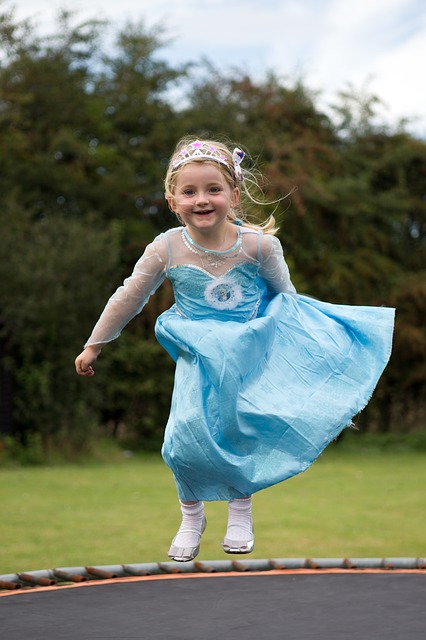This is the third article on osteoporosis I am writing because some new information about osteoporosis has been revealed in the last couple of years. I know most of you think about osteoporosis as an old  person’s disease since that is when you typically experience the broken hips and collapsed vertebra that this disease is famous for. The current medical approach is to advise you to take 1200 mg of calcium a day for prevention, then when that does not work you are put on osteoporosis drugs. Really forward-thinking doctors will even tell you to be sure you are getting enough vitamin D. This is all well and good, but it misses some much bigger issues.
person’s disease since that is when you typically experience the broken hips and collapsed vertebra that this disease is famous for. The current medical approach is to advise you to take 1200 mg of calcium a day for prevention, then when that does not work you are put on osteoporosis drugs. Really forward-thinking doctors will even tell you to be sure you are getting enough vitamin D. This is all well and good, but it misses some much bigger issues.
Osteoporosis is an autoimmune disease; that’s right, just like Lupus and Hashimoto’s and Psoriasis. In autoimmune diseases, your immune system starts attacking your own healthy cells. In the case of osteoporosis, the immune system attacks the cells (osteoblasts) that lay down new bone. The cells that reabsorb old bone (osteoclasts) keep on reabsorbing bone, but new bone to replace that old bone is not 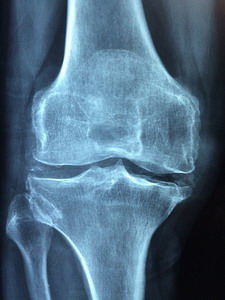 happening. Gradually your bones get thinner and thinner. Why does your body constantly tear down and rebuild your bones? This is to keep your bones strong and always adapting to the stresses you put on them. Normal activities create tiny micro fractures all the time in the bones. This is just like all the tiny cracks and potholes that we get on our roads. The repair crew has to come along and tear out the damaged areas and then lay down fresh asphalt. Our bones act like that when healthy.
happening. Gradually your bones get thinner and thinner. Why does your body constantly tear down and rebuild your bones? This is to keep your bones strong and always adapting to the stresses you put on them. Normal activities create tiny micro fractures all the time in the bones. This is just like all the tiny cracks and potholes that we get on our roads. The repair crew has to come along and tear out the damaged areas and then lay down fresh asphalt. Our bones act like that when healthy.
The key signaling system your bones have to tell the body when a repair is needed is an electrical signal the bones create when they are stressed and they flex a tiny bit. This is why bones get weak if you don’t exercise them. We have all heard that we need 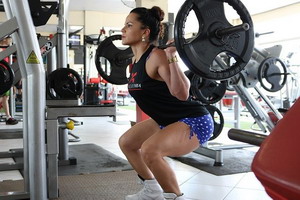 weight-bearing exercise, meaning there has to be enough weight on the bones to generate those electrical signals. But until recently just how much weight was not known. The old idea was that walking would be enough to exercise those bones. It is not enough. The new information is that we need to stress the bones with a weight equal to three to four times our body weight for a few seconds several times a week. That seems like an awful lot. How often do we do that?
weight-bearing exercise, meaning there has to be enough weight on the bones to generate those electrical signals. But until recently just how much weight was not known. The old idea was that walking would be enough to exercise those bones. It is not enough. The new information is that we need to stress the bones with a weight equal to three to four times our body weight for a few seconds several times a week. That seems like an awful lot. How often do we do that?
One article I came across mentioned that gymnasts regularly stress their bones with pressures up to ten times their body weight when they do those flying dismounts off the parallel bars and rings. This is a 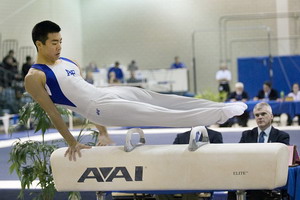 key piece of information. Our bones experience high-stress loads when we jump down from high places. The question was how high? It took a lot of research to find out the answer to what seems like a simple question – how high? There was a boatload of math that involved measurements that I did not have involving deformation of the ground when we land and stuff like that. Finally, I found a source of information on the impact force experienced by tree rigging when a log was dropped from a cutting on the tree. The final result said that when you jump down from a height of two feet, your impact will be roughly equal to three times your weight. Since the average step is 7 to 8 inches, that means we just have to jump down the height of three steps regularly. I did do that when I was younger, but not so much these days. I expect I could, but why would I until I knew this? The message here is that bone-strengthening needs to start while we are young and agile.
key piece of information. Our bones experience high-stress loads when we jump down from high places. The question was how high? It took a lot of research to find out the answer to what seems like a simple question – how high? There was a boatload of math that involved measurements that I did not have involving deformation of the ground when we land and stuff like that. Finally, I found a source of information on the impact force experienced by tree rigging when a log was dropped from a cutting on the tree. The final result said that when you jump down from a height of two feet, your impact will be roughly equal to three times your weight. Since the average step is 7 to 8 inches, that means we just have to jump down the height of three steps regularly. I did do that when I was younger, but not so much these days. I expect I could, but why would I until I knew this? The message here is that bone-strengthening needs to start while we are young and agile.
This same sentiment is echoed in the understanding that we are dealing with an autoimmune disease. Osteoporosis starts 20 years before we have any symptoms or fractures. This new understanding has spawned a bone-strengthening gym called Osteostrong that uses special equipment to provide this level of stress to the bones a couple of times a 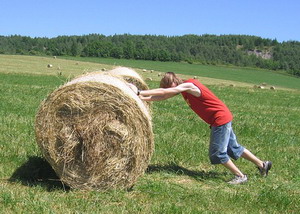 week. The key here is that the body does not have to really move to do this, we just have to push really hard against something to achieve this level of compression. Their equipment is very expensive and only available through a gym membership basis. I am designing a simple device to achieve this at home for the hips, and possibly the low back eventually. But another option is available that is easily attained – rebounding.
week. The key here is that the body does not have to really move to do this, we just have to push really hard against something to achieve this level of compression. Their equipment is very expensive and only available through a gym membership basis. I am designing a simple device to achieve this at home for the hips, and possibly the low back eventually. But another option is available that is easily attained – rebounding.
A rebounder is a small trampoline that you simply bounce up and down on. Yes, you can do all sorts of exercises on them, but for osteoporosis prevention, the up and down bouncing is what we are after. In 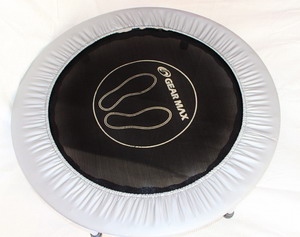 researching this therapy, the studies I came across measured the level of impact compression right in the three to four times body weight range we need. In the old days, balancing on a rebounder could be a serious challenge for many folks. Now, however, many brands have balance bar handles attached to provide balance. The balance challenge is good for us, but not necessary for the bone-stressing we need to build bone.
researching this therapy, the studies I came across measured the level of impact compression right in the three to four times body weight range we need. In the old days, balancing on a rebounder could be a serious challenge for many folks. Now, however, many brands have balance bar handles attached to provide balance. The balance challenge is good for us, but not necessary for the bone-stressing we need to build bone.
So this provides us with a critical bit of information we need to help prevent osteoporosis. Walking around the block, though good for other reasons, is not going 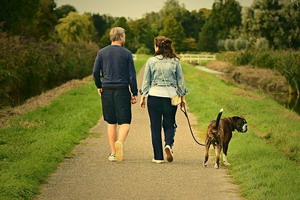 to help prevent osteoporosis. Weight vests that add an extra 20 or 30 pounds also are not going to do the job. It is impact stress that we need, or serious muscle push in the right way – like pushing your car down the street. The first few seconds to get the car rolling will have the kind of stress on the hips needed to signal bone growth cells to go to work.
to help prevent osteoporosis. Weight vests that add an extra 20 or 30 pounds also are not going to do the job. It is impact stress that we need, or serious muscle push in the right way – like pushing your car down the street. The first few seconds to get the car rolling will have the kind of stress on the hips needed to signal bone growth cells to go to work.
Back to the autoimmune issue. If our immune system is attacking our own bone cells, we need to stop this process if we are to make any headway on the osteoporosis. The chief drug classically used for autoimmune flareup is prednisone. This is bad news because prednisone is well known for dissolving our bones and causing osteoporosis at any age, so no  help there. Beyond that, researchers are developing all sorts of gene therapies and immune therapies for some autoimmune diseases. A couple of the latest osteoporosis drug injections fall into this class. These are still fairly new and have a long list of possible side effects, including possible death and inability to fight infections. The old standby now is the bisphosphonate drugs that shut down the bone resorption cells (osteoclasts). Some bone lay-down-cells are still working, so you get patchy coverage for the micro-fractures, but not good repair jobs. Normal hip fractures do decrease with the use of these drugs, but the incidence of atypical fractures goes up do to the poor repair processes.
help there. Beyond that, researchers are developing all sorts of gene therapies and immune therapies for some autoimmune diseases. A couple of the latest osteoporosis drug injections fall into this class. These are still fairly new and have a long list of possible side effects, including possible death and inability to fight infections. The old standby now is the bisphosphonate drugs that shut down the bone resorption cells (osteoclasts). Some bone lay-down-cells are still working, so you get patchy coverage for the micro-fractures, but not good repair jobs. Normal hip fractures do decrease with the use of these drugs, but the incidence of atypical fractures goes up do to the poor repair processes.
At this point, osteoporosis has to be approached like all the other autoimmune diseases – by treating the gut. This is where autoimmune begins. It is the loss of healthy gut function that allows bacterial components to enter the bloodstream (leaky gut) and kick our immune system into overdrive causing autoimmune conditions. What damages the gut the  most are herbicides like Roundup, food poisons, lectins, like those found in wheat (gluten & WGA), and dairy foods. Bad gut bacteria in our microbiome are also key to this process. This is where we start. We have to clean up our diet. Oddly, air pollution also affects our gut lining, so clean air is critical. Autoimmune disease is the new challenge for the 21st century. It is showing up everywhere. Osteoporosis is just one of the common outcomes of our modern western diet.
most are herbicides like Roundup, food poisons, lectins, like those found in wheat (gluten & WGA), and dairy foods. Bad gut bacteria in our microbiome are also key to this process. This is where we start. We have to clean up our diet. Oddly, air pollution also affects our gut lining, so clean air is critical. Autoimmune disease is the new challenge for the 21st century. It is showing up everywhere. Osteoporosis is just one of the common outcomes of our modern western diet.
One protocol that has been getting the best results with autoimmune disease is a nose to tail carnivore diet. Years ago it was feared that a lot of meat would increase our inner acid levels and soften our bones, but this is now known to be completely false. Meat  builds stronger bones, especially the connective tissue in meat, as this is what our body turns into bone tissue. That’s right, bones are mostly protein – collagen type protein. Of course, you want to eat ethically raised pasture and range-fed protein sources as feedlot animals are full of inflammation producing omega 6 oils from the grains they are fed to make them fat; not to mention the antibiotics and hormones they are full of.
builds stronger bones, especially the connective tissue in meat, as this is what our body turns into bone tissue. That’s right, bones are mostly protein – collagen type protein. Of course, you want to eat ethically raised pasture and range-fed protein sources as feedlot animals are full of inflammation producing omega 6 oils from the grains they are fed to make them fat; not to mention the antibiotics and hormones they are full of.
Bottom line, bounce to fight osteoporosis and tackle 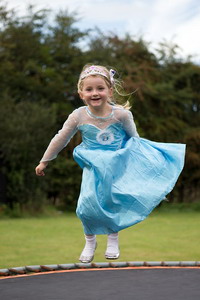 the autoimmune causes behind it early, like 20 years early, before it starts to take you down.
the autoimmune causes behind it early, like 20 years early, before it starts to take you down.
Take care,
David
